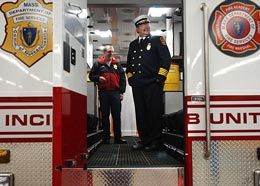
 AP Photo/Josh Reynolds Pittsfield, Mass., Deputy Fire Chief James Sullivan (right) tours a new incident rehab unit in 2005, which was bought with a grant from the DHS. |
To make this process as simple as possible,we need to look no further than the basic rules of writing an effective press release or news article. A successful grant application will answer four classic journalism questions: who, what, why and how?
Who?
The narrative must include a detailed description of the agency or organization applying for the grant. Demographics of the jurisdiction and the agency are vital to convey why the grantee should make an investment in your community. How large or small is the population? How many commercial, industrial and residential buildings or developments are within your jurisdiction?
How is your organization structured? Is your department an agency of local government? Is your agency a regional initiative providing service to many local governments? What are the services provided by your organization? How many personnel does your agency employ? What are the capabilities of those employees? How many responses does your organization make within a year? Answers to these questions should provide a thorough overview of who — both the agency and the jurisdiction — is applying for grant assistance.
What?
The narrative must absolutely include a thorough description of the project to be funded by the grant. The person writing the narrative should bear in mind the reviewer may or may not be a peer reviewer. In some grant review processes, a member of the grant review panel is primarily reviewing the narrative for substantive content describing vulnerability assessment, deficiencies, capabilities and how the grant will address those deficiencies. The reviewer may not know the specific capabilities of the equipment to be funded through the grant. Be certain to address the specifications and capabilities of the asset (i.e., apparatus or equipment being funded).This section should also describe project milestones, if appropriate.
Why?
This portion of the grant narrative is a perfect segue from your description of the "what" that's being funded. Because the first portion of your narrative describes specific vulnerabilities the requested grant will diminish, your narrative should next reference specific goals, objectives, priorities and required task lists from federal and/or state homeland security guidance.
The National Preparedness Guidelines (from the DHS) provide target capabilities, vital missions and critical tasks. It's imperative your narrative include reference to these documents and illustrate that your project goals and objectives not only address local needs, but federal and/or state priorities as well.
How?
This portion of the narrative helps you summarize your answers to the previous questions — who, what and why. Reiterate who's asking for grant assistance, what your organization is attempting to achieve, why the project is important, and how it addresses federal and state homeland security objectives. Finally, this portion should precisely describe how your grant project will improve your organization's capabilities and/or address specific vulnerabilities and deficiencies. Again, the individual who will later review your narrative may not have the knowledge or experience that your organization possesses, so explain to the reviewer how your project will meet the described needs.
It will also be advantageous to describe any mutual aid agreements your organization may be a party to and discuss the availability of the granted equipment to other local, county or state agencies. Based on the guidance document of the individual opportunity, you may need to describe how the project will be sustained after the funding period ends.You may also need to cite additional funding sources, matching funds and external partnerships that will be developed to provide continued financial support.
When preparing your grant application, don't forget that the narrative is the most direct method to sell your application and separate it from the competition. A successful grant application will answer the who, what, why and how. Clearly provide the application reviewer with pertinent details concerning your organization and community. Thoroughly describe what they are funding by awarding your agency. Describe why your project should be awarded before others and which of the federal and/or state homeland security goals, objectives and priorities your project is intended to address. Finally, delineate how the project will improve your organization's capabilities.
Remember to check the specifications listed in the guidance document for a given opportunity to ensure your narrative is prepared in the format and length required. Agencies will improve the likelihood their grant application will be funded if sufficient time and effort is dedicated to thoroughly answering each of these questions.
Copyright © 2024 FireGrantsHelp.com. All rights reserved.